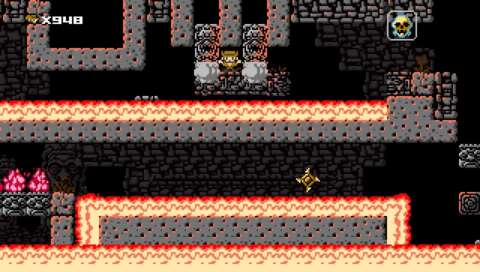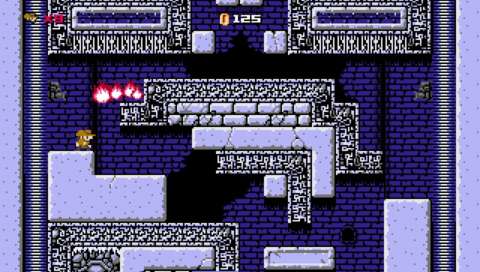1001 Spikes Review
Whether it's entirely true or not, classic games from the NES era are remembered as being far more difficult than the average game today. 1001 Spikes goes all out when attempting to re-create that sense of intense challenge, making a game that not only looks and sounds like one from the 8-bit era, but plays like it as well. But it's not for those who simply want nostalgia. You also need to have patience, perseverance, and a desire for the sweet taste of conquest that comes from every victory.
For the most part, 1001 Spikes plays with all the simplicity of an NES platformer. You can run, you can jump, and you can attack. To jump, however, you have two different buttons: a high jump and a low jump. Jumping low can give you a bit more distance and also gets you back on the ground faster, while jumping high lets you reach more areas and dodge more obstacles. Both types of jumps are essential in different areas, and mastering the ability to use the right jump at the right time is one of 1001 Spikes' earliest and most important challenges. If you get into the habit of using only one type of jump, you will fail.
The goal in 1001 Spikes is simple: collect a key and reach the exit, stopping to pick up a golden skull collectible if you can. While there are occasionally enemies in your way, your toughest opponent is always the environment itself. True to the game's title, spikes are everywhere and often pop out of floors, walls, and ceilings when you don't expect them to. Blocks fall out from under you, arrow traps trigger and kill you, and platforms move and confuse you. The level is your enemy, and it laughs in your face.
But while the stages are antagonistic, they are also fair. Every monster is on a pattern, every trap obeys strict rules, and every movement is precise. When you die, the claim "luck wasn't on my side" is never enough, because there is no element of random chance at play here. You may have gone one pixel too far and died, but that was your fault, not the game's.

This is not to say there is no element of trial and error. It's often the case that you won't know how to finish a stage until you die several (dozen?) times. There may be a block that crumbles the second you stand on it, with no visual cues to warn you that would be the case. Even if you have split-second reaction times, you will probably have to poke and prod at a level before you unlock its secrets. Not only do you need perfect timing and quick reflexes, but you also need the will to fight on until you understand what the level requires.
Of course, dying isn't always fun. Sometimes it's frustrating running through the same areas over and over again. Granted, each level is short (many if not most can be finished in under a minute if you're skilled enough), but beating your head against a wall can grow tiring. Fortunately, there is a level skip option if you simply want to move on, but it can get you only so far. Without completing every stage, you cannot finish the game or unlock the series of even more challenging stages that lie beyond the game's credits.
Blocks fall out from under you, arrow traps trigger and kill you, and platforms move and confuse you. The level is your enemy, and it laughs in your face.
And there's something to be said for perseverance, even when you want to throw your controller out of frustration. After dying more than 50 times in one particular level, I finally got the key and reached the door. But just as the door was opening and I was about to breathe a sigh of relief, a set of spikes came up from the floor and killed me. It would take another couple of dozen tries before I was able to make it to the end and figure out the trick to surviving long enough to successfully exit. It was frustrating, especially since I couldn't merely experiment with the part that was giving me trouble--I had to retry from the beginning.
But with each death, I learned. While at first I was unable to survive more than a couple of seconds on the level in question (and I do mean that literally), I soon found myself expertly navigating through early traps. Even the most daunting obstacles eventually became not only doable, but almost routine. I still died--a lot--but I was making noticeable improvements as I went. The experience was brutal, unforgiving, and frustrating, but it was only beating me because I wasn't good enough. And when I finally bested the level, the exhilaration I felt was something that's not often matched in games.

Though the main story mode will take you many hours to inch your way through, 1001 Spikes comes packed with alternative ways to play. There is a sizable collection of unlockable characters, most coming from other games (such as Bit.Trip Runner and Cave Story) and each with its own unique attributes and abilities. They also have their own stories, though some are far more involved than others.
These characters can also be used in a couple of side games that take the same mechanics and twist the gameplay slightly. The Tower of Nanner mode, for example, has you climbing a series of (mostly) vertically scrolling levels, but lets you continue from where you left off if you die (until you run out of lives). On consoles, these unlockable modes can be played cooperatively as well, which can be frantic and fun, but you're not missing out on too much if you opt for the single-player-only experience on portable systems.
One of the few areas in which 1001 Spikes is lacking is in comparing your performances with other players. The game puts an emphasis on your best times, and even has the option of using a speedrun clock if you so choose, yet there are no online leaderboards with which to compare scores with friends and strangers. That's too bad, because self-imposed misery loves company, and 1001 Spikes is best for the kind of person who can take punishment and enjoy it. It can be soul crushing for the same reason it's inspiring.









